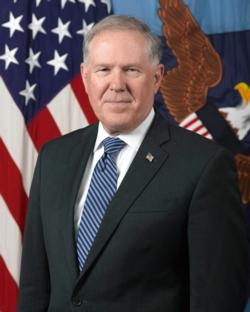Air Force Leadership Defends Program To Senate Appropriations Committee On Defense
Indications are that the F-35 joint strike fighter program -- the most expensive aviation program in Defense Department history -- is on track, the undersecretary of defense for acquisition, technology and logistics told a Senate panel June 19.

Testifying before the Senate Appropriations Committee's defense subcommittee, Frank Kendall (pictured) said the F-35 will be the premier strike aircraft for the Air Force, Navy and Marine Corps. "The department's and my focus has been on the efforts to control costs on the program, and to achieve a more stable design so that we could increase the production rate to more economical quantities," Kendall told the senators. "Indications at this time are that these efforts are succeeding."
The program, begun in President George W. Bush's administration, is about 90 percent through the development program and 40 percent through flight testing. Kendall said he anticipates being able to complete the development effort within the planned cost and schedule. "However, we may need to make some adjustments as events unfold," he added. "On the whole, however, the F-35 design today is much more stable than it was two or three years ago."
Production of the aircraft was in real jeopardy in 2011 amid uncertainty in how design issues would be solved, the undersecretary said. "The F-35 is one of the most concurrent programs I have ever seen, meaning that there is a high degree of overlap between the development phase and the production phase of the program," he said.
Kendall said he believes those questions have been answered, and he told the committee he will review the program later this year to decide whether to increase the production rate significantly in 2015, as is currently planned. "At this point, I am cautiously optimistic that we will be able to do so," he said. Costs per aircraft are coming down, Kendall said. "Since 2010, production costs have been stable and are coming down, ... roughly consistent with our estimates," he said. "We have been tightening the terms of production contracts."
The aircraft builder, Lockheed-Martin, is required to share costs associated with design changes due to concurrency, and the Defense Department is negotiating the next two buys. "In these lots, and all future lots, Lockheed will bear all of the risks of overruns," Kendall said. "At this point we have a solid understanding of the production costs, and believe that they are under control."
The undersecretary said he believes sustainment costs represent the greatest opportunity to reduce life cycle costs of the F-35 going forward.

In his testimony, Air Force chief of staff Gen. Mark A. Welsh III (pictured, left) told the panel that air superiority is critical to the nation's security and how the U.S. military plans to fight. "The air superiority this nation has enjoyed for 60 years is not an accident and gaining and maintaining it is not easy," Welsh said. "It requires trained proficient and ready Airmen and it requires credible, capable and technologically superior aircraft. I believe the F-35 is essential to ensuring we can provide that air superiority in the future."
Welsh said America needs the F-35 to stay a step ahead and to "make sure the future fight is an away game and to minimize our risk to our ground forces when conflict inevitably does occur."
"The F-35 is the only real, viable option to form the backbone of our future fighter fleet," he said. "The F-35 remains the best platform to address the proliferation of highly capable integrated air defenses and new air-to-air threats."
(Photos provided by the U.S. Air Force.)
 ANN's Daily Aero-Linx (04.15.24)
ANN's Daily Aero-Linx (04.15.24) Classic Aero-TV: 'No Other Options' -- The Israeli Air Force's Danny Shapira
Classic Aero-TV: 'No Other Options' -- The Israeli Air Force's Danny Shapira Aero-News: Quote of the Day (04.15.24)
Aero-News: Quote of the Day (04.15.24) Airborne 04.16.24: RV Update, Affordable Flying Expo, Diamond Lil
Airborne 04.16.24: RV Update, Affordable Flying Expo, Diamond Lil ANN's Daily Aero-Term (04.16.24): Chart Supplement US
ANN's Daily Aero-Term (04.16.24): Chart Supplement US




